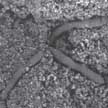Showing Spotlights 2753 - 2760 of 2836 in category All (newest first):
 Silver single crystals were facilely synthesized on a large-scale with good reproducibility in water at room temperature in the presence of carboxyl-functionalized carbon nanotubes, without any additional reducing agent/electrochemical reducing, microwave, sonication or irradiations.
Silver single crystals were facilely synthesized on a large-scale with good reproducibility in water at room temperature in the presence of carboxyl-functionalized carbon nanotubes, without any additional reducing agent/electrochemical reducing, microwave, sonication or irradiations.
Jun 9th, 2006
 The sensitivity of solid-state gas sensors can be improved if the surface-to-volume ratio of the material used for the sensor is increased. An international group of researchers demonstrated that three-dimensional tungsten oxide nanowire networks can serve as a high-surface area material for building ultrasensitive and highly selective gas sensors. The results highlight that the 3-D nanowires technology can be adopted for the development of gas sensors with performances suitable for practical applications.
The sensitivity of solid-state gas sensors can be improved if the surface-to-volume ratio of the material used for the sensor is increased. An international group of researchers demonstrated that three-dimensional tungsten oxide nanowire networks can serve as a high-surface area material for building ultrasensitive and highly selective gas sensors. The results highlight that the 3-D nanowires technology can be adopted for the development of gas sensors with performances suitable for practical applications.
Jun 8th, 2006
 A newly developed electrostatic force directed assembly (ESFDA) technique is used to efficiently coat carbon nanotubes (CNTs) with nanoparticles. This new method advances the current technology by enabling rapid and in-situ coating of CNTs, multicomponent hybrid nanostructures, more control over the assembly process, and the possibility of tuning properties of the resulted hybrid structures.
A newly developed electrostatic force directed assembly (ESFDA) technique is used to efficiently coat carbon nanotubes (CNTs) with nanoparticles. This new method advances the current technology by enabling rapid and in-situ coating of CNTs, multicomponent hybrid nanostructures, more control over the assembly process, and the possibility of tuning properties of the resulted hybrid structures.
Jun 7th, 2006
 A new approach promotes the use of zinc oxide nanomaterials as signal enhancing platforms for rapid, multiplexed, high-throughput, highly sensitive, DNA sensor arrays. Engineered nanoscale ZnO structures can be effectively used for the identification of the biothreat agent, Bacillus anthracis, by successfully discriminating its DNA sequence from other genetically related species.
A new approach promotes the use of zinc oxide nanomaterials as signal enhancing platforms for rapid, multiplexed, high-throughput, highly sensitive, DNA sensor arrays. Engineered nanoscale ZnO structures can be effectively used for the identification of the biothreat agent, Bacillus anthracis, by successfully discriminating its DNA sequence from other genetically related species.
Jun 6th, 2006
 NanoFermentation is the first system to use industrial bioprocessing methods to manufacture nanometer-scale inorganic engineering materials rather than organic compounds. NanoFermentation harnesses the natural metabolic processes of metal-reducing bacteria to create tailored, single-crystal nanoparticles of important engineering materials, particularly ferrites.
NanoFermentation is the first system to use industrial bioprocessing methods to manufacture nanometer-scale inorganic engineering materials rather than organic compounds. NanoFermentation harnesses the natural metabolic processes of metal-reducing bacteria to create tailored, single-crystal nanoparticles of important engineering materials, particularly ferrites.
Jun 5th, 2006
 The extraordinary mechanical properties of carbon nanotubes (CNTs) have generated strong research interest in their possible use in reinforced composite materials. So far, different studies using carbon-nanotube reinforcements in polymer composites have reported only small improvements in the bulk mechanical properties compared with traditional fiber-reinforced composites. Through a novel approach, researchers have created a CNT-based composite material that exhibits significant improvements in fracture performance and structural damping.
The extraordinary mechanical properties of carbon nanotubes (CNTs) have generated strong research interest in their possible use in reinforced composite materials. So far, different studies using carbon-nanotube reinforcements in polymer composites have reported only small improvements in the bulk mechanical properties compared with traditional fiber-reinforced composites. Through a novel approach, researchers have created a CNT-based composite material that exhibits significant improvements in fracture performance and structural damping.
Jun 2nd, 2006
 Optical labeling is an important tool in biological imaging because it offers superb discrimination between the sites of interest and the crowded background of a biological specimen. Diamonds nanocrystals have several advantages over other optical labels and open new opportunities in optical imaging, especially in applications where the size of optical labels represents an important parameter.
Optical labeling is an important tool in biological imaging because it offers superb discrimination between the sites of interest and the crowded background of a biological specimen. Diamonds nanocrystals have several advantages over other optical labels and open new opportunities in optical imaging, especially in applications where the size of optical labels represents an important parameter.
Jun 1st, 2006
 A recent study shows that just by changing the structure of a molecule, without altering its chemical composition, can lead to a variation in the spin-electron interaction strength, and consequently the associated Kondo temperatures.
A recent study shows that just by changing the structure of a molecule, without altering its chemical composition, can lead to a variation in the spin-electron interaction strength, and consequently the associated Kondo temperatures.
May 31st, 2006
 Silver single crystals were facilely synthesized on a large-scale with good reproducibility in water at room temperature in the presence of carboxyl-functionalized carbon nanotubes, without any additional reducing agent/electrochemical reducing, microwave, sonication or irradiations.
Silver single crystals were facilely synthesized on a large-scale with good reproducibility in water at room temperature in the presence of carboxyl-functionalized carbon nanotubes, without any additional reducing agent/electrochemical reducing, microwave, sonication or irradiations.
 Subscribe to our Nanotechnology Spotlight feed
Subscribe to our Nanotechnology Spotlight feed